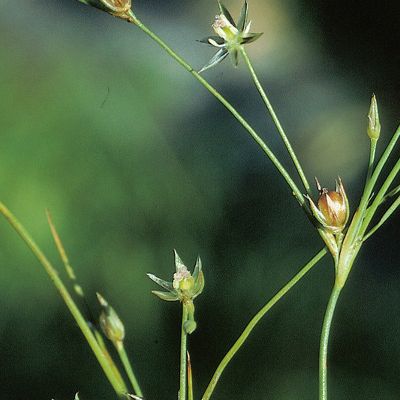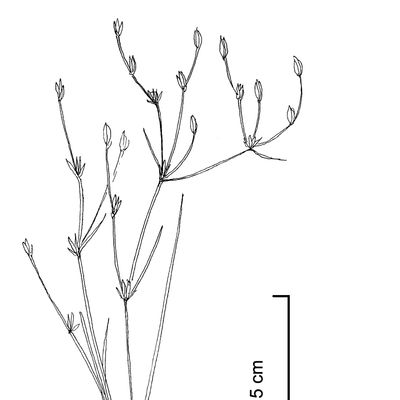Juncus sphaerocarpus Nees
1025060
Species
ISFS : 219500
Checklist : 1025060
ISFS : 219500
Checklist : 1025060
Contains :
Synthesis
Species description (© Flora Helvetica 2018)
Unterscheidet sich von J. bufonius durch folgende Merkmale: Äste des Blütenstandes teilweise herabgebogen. Grösserer Abstand zwischen den einzelnen Blüten. Reife Frucht kugelig. Perigonblätter aufrecht abstehend, länger als der Durchmesser der Frucht. Vielleicht Hybridart J. bufonius x tenageia.Flowering period (© Flora Helvetica 2018)
6-9Habitat and distribution inside Switzerland (© Flora Helvetica 2018)
Schlammige Ufer, feuchte Lehm- und Sandböden / kollin / VSWorld distribution (© Flora Helvetica 2018)
Mediterran-asiatischEcological indicator (© Landolt & al. 2010)
4w+23-44+4.t.2n=36Status
IUCN status
Critically endangeredNational Priority
1 - very high national priorityInternational responsibility
2 - mediumConservation
Threats
Distribution map
Habitat and distribution inside Switzerland
VSWorld distribution
Mediterran-asiatischEcology
Life form
Therophyte
Habitats
Milieux Phytosuisse (© Prunier et al. 2017)
Habitats © Delarze & al. 2015
 | 2.5.1 - Einjährige Schlammflur (Zwergbinsenflur) (Nanocyperion) |
bold
Dominant species, influencing the appearance of the habitat
 Character species
Character species
 Less strictly linked to a specific habitat
Less strictly linked to a specific habitat
Ecological indicator values by © Landolt & al. (2010)
| Soil factors | Climatic factors | Salinity tolerance | |||
|---|---|---|---|---|---|
| Humidity Value H | 4w+ | Light Value L | 4 | Salinity Index | -- |
| Reaction Value R | 2 | Temperature factor T | 4+ | ||
| Nutriments value N | 3 | Continentality K | 4 | ||
- Ecological values legend
Humidity Value H 1 very dry 1+ dry 2 moderatly dry 2+ moist 3 medium wet 3+ wet 4 very wet 4+ soggy 5 submerged or underwater f plants living in running water u mostly submerged plants v partly submerged, partly floating plants w humidity moderately variable (± scale of 1-2) w+ highly variable humidity (scale exceeding ± 2) Reaction Value R 1 Very acid (pH 2.5-5.5) 2 acid (pH 3.5-6.5) 3 lightly acid to neutral (pH 4.5-7.5) 4 neutral to basic (pH 5.5-8.5) 5 basic (pH 6-5 -> 8.5 Nutriments value N 1 very low in nutrients 2 low in nutriments 3 medium-poor to medium-rich in nutrients 4 rich in nutriments 5 very rich in nutriments Salinity tolerance 1 halotolerant 3 halophyle Light Value L 1 very shady 2 shady 3 lighted areas 4 luminous 5 highly luminous Temperature factor T 1 alpine to nival stages (from the treeline to the snowline) 1+ suprasubalpine and upper subalpine levels (pine and larch forests) 2 subalpine level (coniferous forests without beeches up to the upper limit of spruces) 2+ lower subalpine and upper mountain stages 3 mountain level (beech and silver fir forests, in the central Alps Scots pine forests) 3+ lower mountain and upper hill levels 4 hill level (mixed deciduous oak forests) 4+ hot places, hill level 5 very hot places, hill level (only in the hottest places, typical of southern Europe) Continentality K 1 Atlantic (high air humidity, very low temperature variations, mild winters) 2 Sub-Atlantic (high air humidity, low temperature variations, relatively mild winters) 3 sub-Atlantic to subcontinental (average air humidity, moderately variable temperature, slightly low winter temperatures) 4 subcontinental (low air humidity, large temperature variations, rather cold winters) 5 continental (very low air humidity, very large temperature variations, cold winters)
Water dependency
| Rivers | 0 - No link |
| Calm water | 1 - Secondary habitat |
| Ground water | 0 - No link |
Nomenclature
Accepted Name (Checklist 2017)
Juncus sphaerocarpus Nees
Vernacular name
Deutscher Name :
Kugelfrüchtige BinseNom français :
Jonc à fruits globuleuxNome italiano :
Giunco a frutti globosiMatch with other reference books
| Relation | Nom | Book | No |
|---|---|---|---|
| = | Juncus sphaerocarpus Nees | Checklist 2017 | 219500 |
| = | Juncus sphaerocarpus Nees | Flora Helvetica 2001 | 2444 |
| = | Juncus sphaerocarpus Nees | Flora Helvetica 2012 | 2616 |
| = | Juncus sphaerocarpus Nees | Flora Helvetica 2018 | 2616 |
| = | Juncus sphaerocarpus Nees | Index synonymique 1996 | 219500 |
| = | Juncus sphaerocarpus Nees | Landolt 1977 | 583 |
| = | Juncus sphaerocarpus Nees | SISF/ISFS 2 | 219500 |
= The taxon corresponds to the accepted taxon (Checklist 2017)
< The taxon is included in the accepted taxon (Checklist 2017)
> The taxon includes (among others) also the accepted taxon (Checklist 2017)
< The taxon is included in the accepted taxon (Checklist 2017)
> The taxon includes (among others) also the accepted taxon (Checklist 2017)
Status
Native status
-IUCN list of endangered species (© Walter & Gillett 1997) : No
Status on national Red List 2016
IUCN status:
Critically endangered

Additional information
IUCN criteria: C2b
Status on regional Red List 2019
| Biogregraphic regions | Status | IUCN criteria |
|---|---|---|
| Jura (JU) | -- | |
| Mittelland (MP) | -- | |
| Alpennordflanke (NA) | -- | |
| Alpensüdflanke (SA) | -- | |
| Östliche Zentralalpen (EA) | -- | |
| Westliche Zentralalpen (WA) | CR | C2b |
- Legend
EX Extinct RE Regionally Extinct CR(PE) Critically Endangered, Probably Extinct CR Critically Endangered EN Endangered VU Vulnerable NT Near Threatened LC Least Concern DD Data Deficient NE Not Evaluated NA Not Applicable
National Priority Species List Status
| National Priority | 1 - very high national priority |
| Need to take action | 2 - |
| International responsibility | 2 - medium |
| Need to monitor populations | 2 - |
Protection status
| No international, national or cantonal protection |
- Disclaimer
InfoFlora compiles information on protected species as accurately as possible, taking it from the respective cantonal laws. In some cases, however, it was not possible to use the plant names as listed in the original text, but an interpretation of their taxonomy or nomenclature was necessary. The exact meaning of the categories „completely protected“ and „partially protected“ differs among the cantons.
InfoFlora cannot guarantee that the information on the protection status is correct and complete. In case of doubts, we recommend to look up the texts of the respective cantonal law.
Status by sector of activity
| Agriculture-related environmental objectives : | Z - | more informations |
| Forest management environmental objectives : | more informations |

